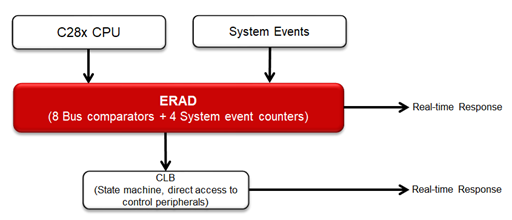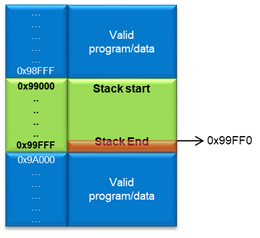SPRACN0F October 2021 – March 2023 TMS320F280021 , TMS320F280021-Q1 , TMS320F280023 , TMS320F280023-Q1 , TMS320F280023C , TMS320F280025 , TMS320F280025-Q1 , TMS320F280025C , TMS320F280025C-Q1 , TMS320F280033 , TMS320F280034 , TMS320F280034-Q1 , TMS320F280036-Q1 , TMS320F280036C-Q1 , TMS320F280037 , TMS320F280037-Q1 , TMS320F280037C , TMS320F280037C-Q1 , TMS320F280038-Q1 , TMS320F280038C-Q1 , TMS320F280039 , TMS320F280039-Q1 , TMS320F280039C , TMS320F280039C-Q1 , TMS320F280040-Q1 , TMS320F280040C-Q1 , TMS320F280041 , TMS320F280041-Q1 , TMS320F280041C , TMS320F280041C-Q1 , TMS320F280045 , TMS320F280048-Q1 , TMS320F280048C-Q1 , TMS320F280049 , TMS320F280049-Q1 , TMS320F280049C , TMS320F280049C-Q1 , TMS320F28374D , TMS320F28374S , TMS320F28375D , TMS320F28375S , TMS320F28375S-Q1 , TMS320F28376D , TMS320F28376S , TMS320F28377S , TMS320F28377S-Q1 , TMS320F28378D , TMS320F28378S , TMS320F28379D , TMS320F28379D-Q1 , TMS320F28379S , TMS320F28384D , TMS320F28384S , TMS320F28386D , TMS320F28386S , TMS320F28388D , TMS320F28388S , TMS320F28P650DH , TMS320F28P650DK , TMS320F28P650SH , TMS320F28P650SK , TMS320F28P659DH-Q1 , TMS320F28P659DK-Q1 , TMS320F28P659SH-Q1
- The Essential Guide for Developing With C2000™ Real-Time Microcontrollers
- Trademarks
- 1C2000 and Real-Time Control
-
2Sensing Key Technologies
- 2.1 Accurate Digital Domain Representation of Analog Signals
- 2.2 Optimizing Acquisition Time vs Circuit Complexity for Analog Inputs
- 2.3 Hardware Based Monitoring of Dual-Thresholds Using a Single Pin Reference
- 2.4 Resolving Tolerance and Aging Effects During ADC Sampling
- 2.5 Realizing Rotary Sensing Solutions Using C2000 Configurable Logic Block
- 2.6 Smart Sensing Across An Isolation Boundary
- 2.7 Enabling Intra-Period Updates in High Bandwidth Control Topologies
- 2.8 Accurate Monitoring of Real-Time Control System Events Without the Need for Signal Conditioning
-
3Processing Key Technologies
- 3.1 Accelerated Trigonometric Math Functions
- 3.2 Fast Onboard Integer Division
- 3.3 Hardware Support for Double-Precision Floating-Point Operations
- 3.4 Increasing Control Loop Bandwidth With An Independent Processing Unit
- 3.5 Flexible System Interconnect: C2000 X-Bar
- 3.6 Improving Control Performance With Nonlinear PID Control
- 3.7 Understanding Flash Memory Performance In Real-Time Control Applications
- 3.8 Deterministic Program Execution With the C28x DSP Core
- 3.9 Efficient Live Firmware Updates (LFU) and Firmware Over-The-Air (FOTA) updates
-
4Control Key Technologies
- 4.1 Reducing Limit Cycling in Control Systems With C2000 HRPWMs
- 4.2 Shoot Through Prevention for Current Control Topologies With Configurable Deadband
- 4.3 On-Chip Hardware Customization Using the C2000 Configurable Logic Block
- 4.4 Fast Detection of Over and Under Currents and Voltages
- 4.5 Improving System Power Density With High Resolution Phase Control
- 4.6 Safe and Optimized PWM Updates in High-Frequency, Multi-Phase and Variable Frequency Topologies
- 4.7 Solving Event Synchronization Across Multiple Controllers in Decentralized Control Systems
- 5Interface Key Technologies
- 6Safety Key Technologies
- 7References
- 8Revision History
6.1.2 In Depth
ERAD is a hardware module with enhanced bus comparators and system event counters that sits within the MCU bus architecture as shown in #GUID-415E5E0E-C32B-4284-B016-78A49D42D806. ERAD on its own can generate system level interrupts and flags and can also feed into other peripherals such as the CLB for further enhancing the capabilities. For complete understanding of the relationship between these two modules, see the CLB documentation.
 Figure 6-1 ERAD Block
Diagram
Figure 6-1 ERAD Block
DiagramEnhanced bus comparator monitors some of the critical CPU internal buses and signals that convey information about the CPU code execution and pipeline. Most of the critical CPU interfaces are monitored by EBC units, which can be configured to match any address/data/instruction patterns that appear on the CPU interface and generate events based on this. A simple example would be to generate an event when an address of interest is accessed for a read or write. Additionally these events can be exported to CLB to define state machines to keep track of sequences of these events.
On the other hand, system event counters monitor various events in the system like interrupts and peripheral activity which is another important requirement for any real-time system to monitor and profile. All the key system events like interrupts, DMA triggers and important peripheral events (via interrupts, CLA events, and so forth) are available for profiling inside of the ERAD. Hence, these can be time-stamped, counted and measured with relation to the CPU activity. Enhanced counter block allows the system events as well as CPU activity to be measured and analyzed with reference to other events too.
Example: Stack Overflow Detection
A frequently encountered issue with embedded code development is detecting an overflowing stack. ERAD can simply use a single enhanced bus-comparator unit and then map the stack end address with a small margin to generate an interrupt when there is a write that is attempted. With the below example (#FIG_WSG_B1H_5MB), just use a comparator with address 0x99FF0 and mask the last 4-bits for comparison, so any write access between addresses 0x99FF0 to 0x99FFF would generate an event/interrupt, which can then be handled appropriately based on kind of the application.
 Figure 6-2 Stack Overflow
Protection
Figure 6-2 Stack Overflow
Protection